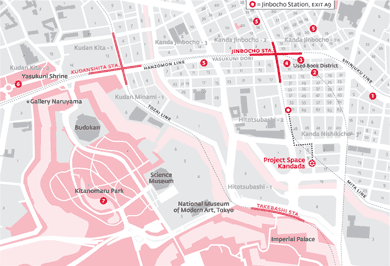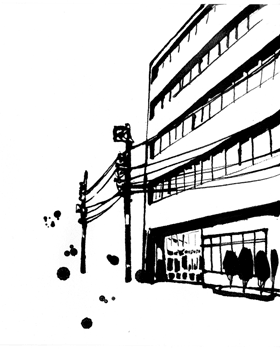Project Space Kandada
in Jinbocho / Kanda

download a pdf of this map (2.3mb)
access and details
Station: Jinbocho
Lines: Hanzomon, Mita, Shinjuku
Access: 3 minute walk from exit A9
Entry: Free
Address: Seikosha 1F, 3-9 Kanda
Nishikicho, Chiyoda-ku, Tokyo
Hours: 12pm – 7pm
Closed on Sundays, Mondays
Tel: +81-(0)3-3518-6176
URL: http://commandn.net
Email: kandada@commandn.net
In The Neighborhood
Jinbocho, a jungle of used Japanese books, is a bibliophile’s utopia. Head into Book Brother[1] for used art and design tomes, or wander in and out of the back-alley shops[2] displaying their wares on the street. Café Brazil[3] will delight any coffee lover looking for a serious cuppa joe, and Café Saboru[4] is worth a stop for the wild scribbles on the walls. If you’re hungry, one of the Imoya branches[5] for tendon or tonkatsu is never a bad idea. Time permitting it’s just a short walk up to the controversial but stunning Yasukuni Shrine[6]. Should you start to feel tired, the benches along the lake at Kitanomaru Park[7] offer a welcome respite from all the hard edges of city life.
About the Space
Exterior

Background Information
Sitting on the edge of Jinbocho, Project Space Kandada occupies a renovated printing warehouse and feels like a rough cut of the typical white cubes that are so prevalent in the city.
Kandada’s simple configuration — the main space with its high ceiling, subdivided by a smaller box — affords it the versatility to stage ambitious large-scale installations together with smaller, more enclosed displays. Be it a wall covered in pachinko parlor balls, a database of visitors’ dating experiences, or a huge sculpture of a Japanese telecommunications satellite, exhibitions here are never predictable.
Although exhibitions and events are held here, Project Space Kandada is founded on a more fluid conception of art space than you would usually find. Run by the nonprofit art collective commandN, the current gallery space moved here in 2005 after several relocations.
Deriving its name from the surrounding Kanda area and the Dada cross-media movement of the early 20th century, Project Space Kandada functions as a base of operations for activities that reach well beyond the gallery walls to engage with public space and communities in Tokyo and elsewhere in Japan. This approach is neatly summed up in an artwork by Hiroko Ichihara that you may notice on the counter: a small backlit sign on which three characters read ‘bijutsuchu’ — ‘Art in Progress.’